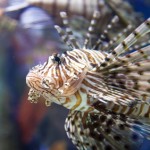I normally think of invasive species as plants that are non-indigenous, kudzu comes to mind. Actually, in our Colorado garden areas, a plant called bindweed invades and takes over unless we are diligent about weeding. When I Googled it, I found it did indeed meet the definition more commonly used, a plant or animal imported from another country or continent (in bindweed's case Eurasia), sometimes for seemingly logical reasons (e.g., as an ornamental or to control another species regarded as a pest).
But let's switch gears. There was an article in The New York Times on July 10, 2011 that caught my attention. Its title was "Answer for Invasive Species: Put It on a Plate and Eat It," and it began with a photo of a flamboyant fish, the lionfish. That led me to the website for Food and Water Watch, a non-profit, independent organization with an impressive and eclectic Board of Directors and a mission to ensure the food, water and fish we consume are safe, accessible and sustainably produced.
Their 2011 Smart Seafood Guide now has "Recommended Invasive Species" Many of these, once introduced into a new habitat, have no natural predators, so the suggestion is that we fill that niche. For instance we could eat the lionfish, which, according to the NYT article, is devastating reef fish, both in the Caribbean and coastally, off Florida. But caught by spearfishing and braised in brown butter sauce, lionfish tastes wonderful.
The Nature Conservancy sponsored a lionfish food fair a year ago, paying local fisherfolk $11 a pound for the pesty fish. The fritters made from this invasive species went over well with the crowd. There was concern with lionfish, as with many other species, about the possibility of toxins from microbes, so selective fishing from "clean" areas was necessary.
The Smart Seafood Guide I downloaded from Food and Water Watch lists eight other species as potential menu items. Asian carp, which are not bottom feeders, are caught with nets of several kinds or even on hook and line. They've spread from the Southeast through floods and are moving toward the great Lakes. They eat plankton in amounts out of proportion to their size and thus compete with native fishes. They're a bony fish and a NYC chef, the James Beard Foundation and Food and Water Watch have combined in an effort to develop recipes for these and others of the unwanted species.
The Beard Foundation's VP noted that we've gone from weeding out some plant species to regarding them as delicacies; perhaps we can do the same with our Asian crabs, Asian carp, lionfish, Asian swamp eels, Chinese mitten crabs, European green crabs, rusty crayfish, walking catfish (able to live out of water for short periods and move short distances on land), and two species of tilapia.
There are a number of other avenues being explored to control these critters and we'll also need to prevent their deliberate further spread once the profit motivation comes into play.
But to me, it sounds like it's time for a fish dinner



